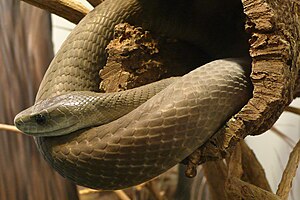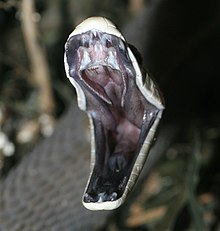Black mamba
| Black mamba | ||||||||||||
|---|---|---|---|---|---|---|---|---|---|---|---|---|

Black mamba |
||||||||||||
| Systematics | ||||||||||||
|
||||||||||||
| Scientific name | ||||||||||||
| Dendroaspis polylepis | ||||||||||||
| Günther , 1864 |
The black mamba ( Dendroaspis polylepis ) is the longest venomous snake in Africa with an average length of around 2.50 meters and a maximum length of over 4.50 meters .
features
The black mamba is the second longest venomous snake in the world after the king cobra . The color of the animals varies between olive brown, dark brown and dark gray. Young snakes are lighter in color. The rear part of the back can also be darkly spotted. The ventral side, on the other hand, is cream-colored, partly yellow or greenish piebald. In the middle of the body, the back scales lie in 23 to 25, rarely 27, rows of scales around the body.
The name is not derived from the color of the skin, but the dark inside of the mouth, the color of which varies between dark blue and ink black. The eyes are dark brown to black and have a silver-white to yellow border around the round pupils.
distribution and habitat
The black mamba is native to south and east Africa south of the Sahara . The northernmost occurrences are in eastern Africa in Eritrea and in the west in Namibia . Alleged evidence from West Africa (Senegal) from the 1950s is doubtful.
As a habitat, the snake prefers wooded savannah areas , stony hills and forests on rivers. She uses hollows under stones, hollow trees and termite structures as hiding places . As a rule, it lives on the ground, but it can also climb and move in trees.
Way of life
The black mamba is a diurnal loner who is mainly active a few hours after sunrise to about an hour before sunset. Contact with other black mambas is limited to the mating season, and there is no pairing even after mating. Mambas regularly use sunny spots for sunbathing. The speed at which they move is up to 20 km / h, which makes this species one of the fastest snakes. While moving, only about two thirds of the body touch the ground, the front third is raised.
nutrition
The black mamba mainly feeds on small mammals such as mice and rats, squirrels and snakes , and rarely hunts birds. It hunts by sneaking up on the prey, then biting briefly and then withdrawing until the neurotoxin paralyzes the prey. Bird holds her tightly until the poison takes effect. Death usually occurs through respiratory paralysis. The prey is swallowed whole and digested within eight to ten hours.
defense
Little or nothing is known about the predators of the black mamba. As with many snakes, other snakes, crocodiles , monitor lizards and birds of prey are primarily used as predators .
The black mamba is usually shy and often hides; she tries to withdraw in the event of a fault If retreat is not possible, it is aggressive and uses its bite as a defense. When attacking, the snake lifts its front body, opens its mouth and hisses just before striking. This is done very quickly and often several times in a row. If the disturber slowly withdraws at the threatening gesture, the snake tries to escape too.
Reproduction and development
Little is known about the reproduction and development of the black mamba. The mating season of the black mamba is in spring. The males find the females via a scent trail and check them by running their tongue (and thus their olfactory organ) over the body of the female. Competing males engage in rival fights by entwining their bodies and rising up to three feet from the ground. Long-lasting copulation occurs when the hemipenis is inserted into the female cloaca . After mating, the animals separate again.
The approximately 6 to 17 eggs of the oviparous species are laid in a suitable substrate after approximately two to three months and left to fend for themselves. They develop for another two to three months after filing. When hatching, the young snakes open the egg shell with the help of an egg tooth , the animals are fully developed and can look for food themselves. However, the yolk they have ingested provides them with food for a while. The poison glands and fangs are also fully developed at the time of birth.
As with most snakes, nothing is known about the species' lifespan in the wild. The longest period a black mamba can be kept is around eleven years, but it is believed that they can get older.
Systematics
In addition to the black mamba, there are three other species in the genus Dendroaspis :
- Green mamba ( Dendroaspis viridis )
- Common mamba ( Dendroaspis angusticeps )
- Jameson's Mamba ( Dendroaspis jamesoni )
Toxic effect on humans
Encounters between the black mamba and humans are relatively frequent, as the snake is not infrequently located near human settlements and the resting place is often sought in the roof of an inhabited house or in the outbuildings of a farm. Although the snake mostly avoids humans, it is still considered to be significantly more aggressive than many other poisonous snakes.
The poison of the black mamba is - like that of other mamba species - a neurotoxin and also very dangerous for humans. The effect is essentially caused by several peptides of different lengths. In addition to the neurotoxic effect, cardio and cytotoxins also damage the heart muscle tissue. The dendrotoxins contained only in the poison of the species of mamba block certain subtypes of voltage-controlled potassium channels , which u. a. cause a disturbance of the electrical stimulus propagation in the heart and can be associated with cardiac arrhythmias . With one bite, it can inject up to 400 milligrams of venom into the wound. Even an amount of 15 to 20 milligrams can be fatal in an adult and, in extreme cases, can lead to death within 20 minutes from respiratory failure.
In October 2012, French pharmacologists reported on two newly discovered peptides in poison, so-called mambalgins , which in animal experiments showed a strong analgesic effect by blocking the proton-dependent cation channels in the nerve cell.
Footnotes
- ↑ Dendroaspis species; Mamba species , gifte.de, accessed on October 24, 2015
- ↑ Wolfgang Forth (Ed.): General and special pharmacology and toxicology . 7th edition. Spektrum Verlag, Heidelberg 1996, ISBN 3-8274-0088-0 , p. 891, chapter 32.10.
- ↑ Mambalgin: Snake venom could relieve pain , Deutsches Ärzteblatt, October 4, 2012
- ↑ Sylvie Diochot et al: Black mamba venom peptides target acid-sensing ion channels to abolish pain. Nature 490, 552-555, October 25, 2012. doi : 10.1038 / nature11494 .
Web links
- Dendroaspis polylepis in The Reptile Database
- Portrait in Animal Diversity Net (English)
- Dendroaspis polylepis inthe IUCN Red List of Threatened Species 2013.1. Posted by: Spawls, S., 2009. Retrieved October 9, 2013.
literature
- Bill Branch: Field Guide to the Snakes and Other Reptiles of Southern Africa . Ralph Curtiss Books, Sanibel Island, Fla. 1998, ISBN 0-88359-042-5 (reprint of the Cape Town edition 1988).
- Vivian FitzSimons: A Field Guide to the Snakes of Southern Africa . Collins, London 1978, ISBN 0-00-219327-2 (reprint of the London 1970 edition).
- John Marais: A Complete Guide to the Snakes of Southern Africa . 2nd edition Struik Press, Cape Town 2004, ISBN 1-86872-932-X .
- Stephen Spawls, Bill Branch: The Dangerous Snakes of Africa. Natural history, species directory, venoms and snakebite . Blandford, London 1995, ISBN 0-7137-2394-7 .

